Influence of Bubbles Causing Cavitation on Spool Oscillation of a Direct Drive Servovalve
Abstract
:1. Introduction
2. Numerical Methods
2.1. Structure of the Servovalve
2.2. Simulation Approaches
2.3. Transient Cavitation Evaluation
3. Results and Discussion
3.1. Cavitation in the Valve Cavity
3.2. Influencing Factor
4. Conclusions
- (1)
- The oil return valve cavity is the major region of bubble concentration due to its cavitation.
- (2)
- The average cavitation fraction was evaluated at selected monitoring positions. The numerical results indicate that the bubbles in the valve cavity greatly change, although the growth, evolution, and collapse stages are cyclical. Analysis of the pressure and the local cavitation volume fraction at each monitoring point suggests a strong correlation between the pressure fluctuation and the amount of cavitation.
- (3)
- A spectrum analysis of the average cavitation fraction and the average pressure on the surface of the convex shoulder were both almost identical. This suggests that the leading cause of cavitation is the pressure pulsation. If we increase the pressure at the return port of the valve, this can inhibit oscillation. Whereas, the amplitude and frequency of pressure pulsation are boosted with an increase in inlet pressure.
Author Contributions
Funding
Conflicts of Interest
References
- Luo, L.; Ding, X. Design and verification of aircraft electro-hydraulic servo nose wheel steering system. In Proceedings of the CSAA/IET International Scientific-Technical Conference on Actual Problems of Electronics Instrument Engineering, Guiyang, China, 19–22 June 2018. [Google Scholar]
- Fang, Q.; Wang, Z. Hydraulics. Developing Process, Research Actuality and Trend of Electrohydraulic Servovalve. Mach. Tool Hydraul. 2007, 35, 162–165. [Google Scholar]
- McHenya, J.M.; Zhang, S.Z.; Li, S.J. Visualization of Flow-Field between the Flapper and Nozzle in a Hydraulic Servo-Valve. Adv. Mater. Res. 2011, 402, 407–411. [Google Scholar] [CrossRef]
- Zhang, S.; Li, S. Cavity shedding dynamics in a flapper-nozzle pilot stage of an electro-hydraulic servo-valve: Experiments and numerical study. Energy Convers. Manag. 2015, 100, 370–379. [Google Scholar] [CrossRef]
- Saha, B.K.; Peng, J.; Li, S. Numerical and Experimental Investigations of Cavitation Phenomena Inside the Pilot Stage of the Deflector Jet Servo-Valve. IEEE Access 2020, 8, 64238–64249. [Google Scholar] [CrossRef]
- Lindler, J.E.; Anderson, E.H. Piezoelectric direct drive servovalve. Int. Soc. Opt. Photonics 2002, 4698, 488–496. [Google Scholar]
- Urai, T.; Sugiyama, T. Development of a Direct drive Servovalve Using a Giant Magnetostrictive Material. Proc. JFPS Int. Symp. Fluid Power 1993, 59, 2112–2115. [Google Scholar]
- Tu, S.; Wang, C.; Tang, Y.L.; Dong, D.; Shi, Y.J. Experimental Study on the Flow and Vibration Characteristics of Dual Spool Sleeve Valve. Appl. Mech. Mater. 2013, 347–350, 529–534. [Google Scholar] [CrossRef]
- Hanlin, H.E.; Zhang, Z.; Xiaojun, L.V. Analysis of High-frequency Oscillation of Servovalve. Procedia Eng. 2019, 47, 229–231. [Google Scholar]
- Li, S.J.; Peng, J.H.; Zhang, S.Z.; McHenya, J.M. Depression of Self-Excited Pressure Oscillations and Noise in the Pilot Stage of a Hydraulic Jet-Pipe Servo-Valve Using Magnetic Fluids. Adv. Mater. Res. 2011, 378–379, 632–635. [Google Scholar] [CrossRef]
- Elsheikh, M.M.J.D. A Numerical and Experimental Investigation of Flow Induced Noise in Hydraulic Counterbalance Valves. Ph.D. Thesis, University of South Florida, Tampa, FL, USA, 2015. [Google Scholar]
- Aung, N.Z.; Li, S. A numerical study of cavitation phenomenon in a flapper-nozzle pilot stage of an electrohydraulic servo-valve with an innovative flapper shape. Energy Convers. Manag. 2014, 77, 31–39. [Google Scholar] [CrossRef]
- Li, S.; Mchenya, M.; Zhang, S.J.I. Study of jet flow with vortex and pressure oscillations between the flapper—Nozzle in a hydraulic servo-valve. In Proceedings of the World Automation Congress (WAC), Puerto Vallarta, Mexico, 24–28 June 2012. [Google Scholar]
- Ziada, S.; Bühlmann, E.T.; Bolleter, U. Flow impingement as an excitation source in control valves. J. Fluids Struct. 1989, 3, 529–549. [Google Scholar] [CrossRef]
- Gao, D.; Qiao, H.; Lu, X. Finite Element Numerical Simulation and PIV Measurement of Flow Field inside Metering-in Spool Valve. Chin. J. Mech. Eng. Engl. Ed. 2009, 22, 102–108. [Google Scholar] [CrossRef]
- Li, Z.; Luo, J.; Yuan, R.B.; He, M. The CFD Analysis of Twin Flapper -nozzle Valve in Pure Water Hydraulic. Procedia Eng. 2012, 31, 220–227. [Google Scholar]
- Liu, X.; He, J.; Li, B.; Zhang, C.; Xie, F.J.S. Study on Unsteady Cavitation Flow and Pressure Pulsation Characteristics in the Regulating Valve. Shock. Vib. 2021, 2021, 1–10. [Google Scholar]
- Qiu, C.; Jiang, C.H.; Zhang, H.; Wu, J.Y.; Jin, Z.J.J.P. Pressure Drop and Cavitation Analysis on Sleeve Regulating Valve. Processes 2019, 7, 829. [Google Scholar] [CrossRef] [Green Version]
- Yu, J.; Zhuang, J.; Yu, D. Modeling and Analysis of A Rotary Direct Drive Servovalve. Chin. J. Mech. Eng. 2014, 27, 1064–1074. [Google Scholar] [CrossRef]
- Shen, C. New type piezoelectric direct drive servovalve. Chin. J. Mech. Eng. 2004, 40, 125–128. [Google Scholar] [CrossRef]
- Zhu, M.; Zhao, S.; Dong, P.; Li, J. Design and analysis of a novel double-servo direct drive rotary valve with high frequency. J. Mech. Sci. Technol. 2018, 32, 4213–4223. [Google Scholar] [CrossRef]
- Qian, J.Y.; Liu, B.Z.; Jin, Z.J.; Wang, J.K.; Zhang, H.; An-Le, L.U.J. Numerical analysis of flow and cavitation characteristics in a pilot-control globe valve with different valve core displacements. J. Zhejiang Univ. Sci. 2016, 17, 54–64. [Google Scholar] [CrossRef] [Green Version]
- Amirante, R.; Distaso, E.; Tamburrano, P. Experimental and numerical analysis of cavitation in hydraulic proportional directional valves. Energy Convers. Manag. 2014, 87, 208–219. [Google Scholar] [CrossRef]
- Li, J.-y.; Gao, Z.-x.; Wu, H.; Jin, Z.-j. Numerical Investigation of Methodologies for Cavitation Suppression Inside Globe Valves. Appl. Sci. 2020, 10, 5541. [Google Scholar] [CrossRef]
- Zwart, P.J.; Gerber, A.G.; Belamri, T. A two-phase flow model for predicting cavitation dynamics. In Proceedings of the International Conference on Multiphase Flow, Yokohama, Japan, 30 May–3 June 2004; 152. [Google Scholar]
- Jin, Z.J.; Gao, Z.X.; Qian, J.Y.; Wu, Z.; Sunden, B. A parametric study of hydrodynamic cavitation inside globe valves. J. Fluids Eng. 2017, 140, 3. [Google Scholar] [CrossRef]
- Dai, S.; Younis, B.A.; Sun, L. Large-Eddy Simulations of cavitation in a square surface cavity. Appl. Math. Model. 2014, 38, 5665–5683. [Google Scholar] [CrossRef]
- Zhang, D.; Shi, L.; Shi, W.; Zhao, R.; Wang, H.; van Esch, B.P.M. Numerical analysis of unsteady tip leakage vortex cavitation cloud and unstable suction-side-perpendicular cavitating vortices in an axial flow pump. Int. J. Multiph. Flow 2015, 77, 244–259. [Google Scholar] [CrossRef]
- Roohi, E.; Zahiri, A.P.; Passandideh-Fard, M.J.A.M.M. Numerical simulation of cavitation around a two-dimensional hydrofoil using VOF method and LES turbulence model. Appl. Math. Model. 2013, 37, 6469–6488. [Google Scholar] [CrossRef]
- Chern, M.J.; Hsu, P.H.; Cheng, Y.J.; Tseng, P.Y.; Hu, C.M. Numerical Study on Cavitation Occurrence in Globe Valve. J. Energy Eng. 2013, 139, 25–34. [Google Scholar] [CrossRef]



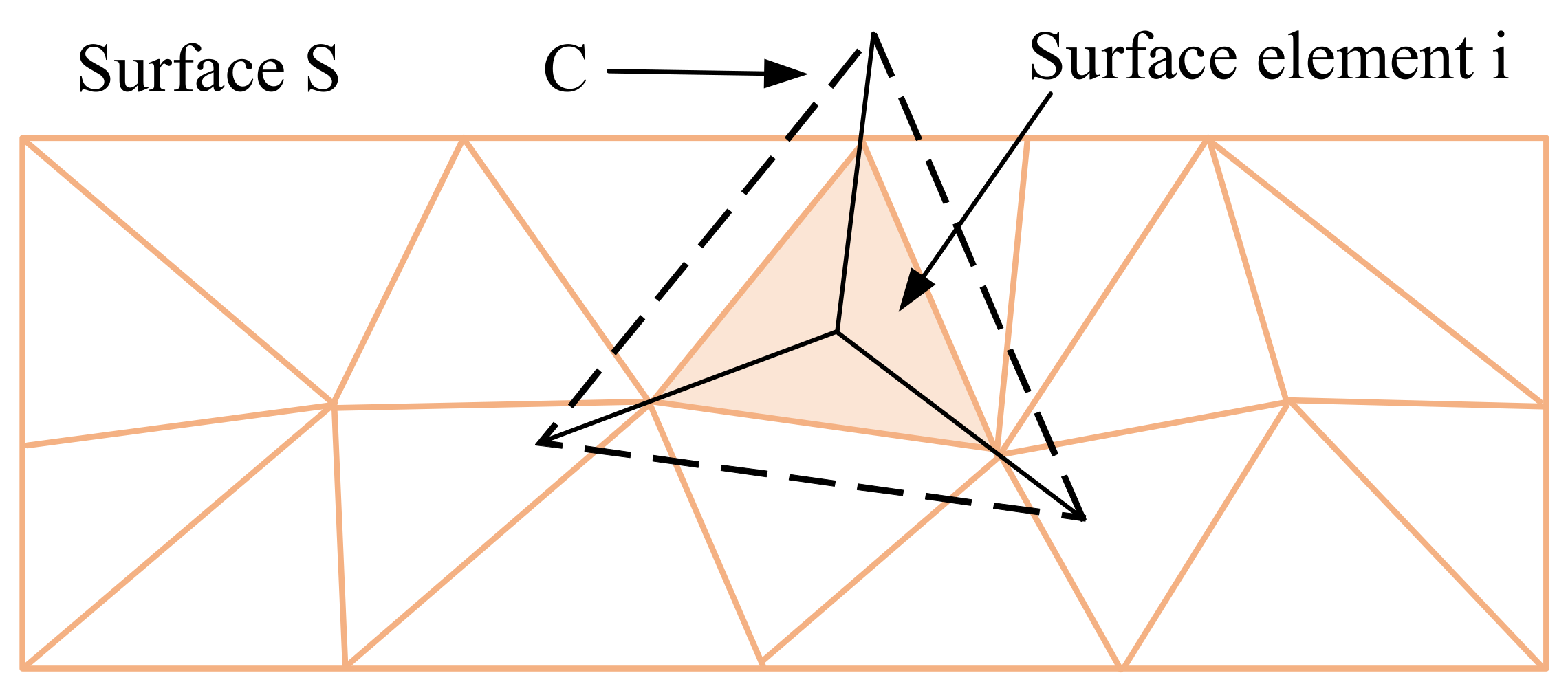
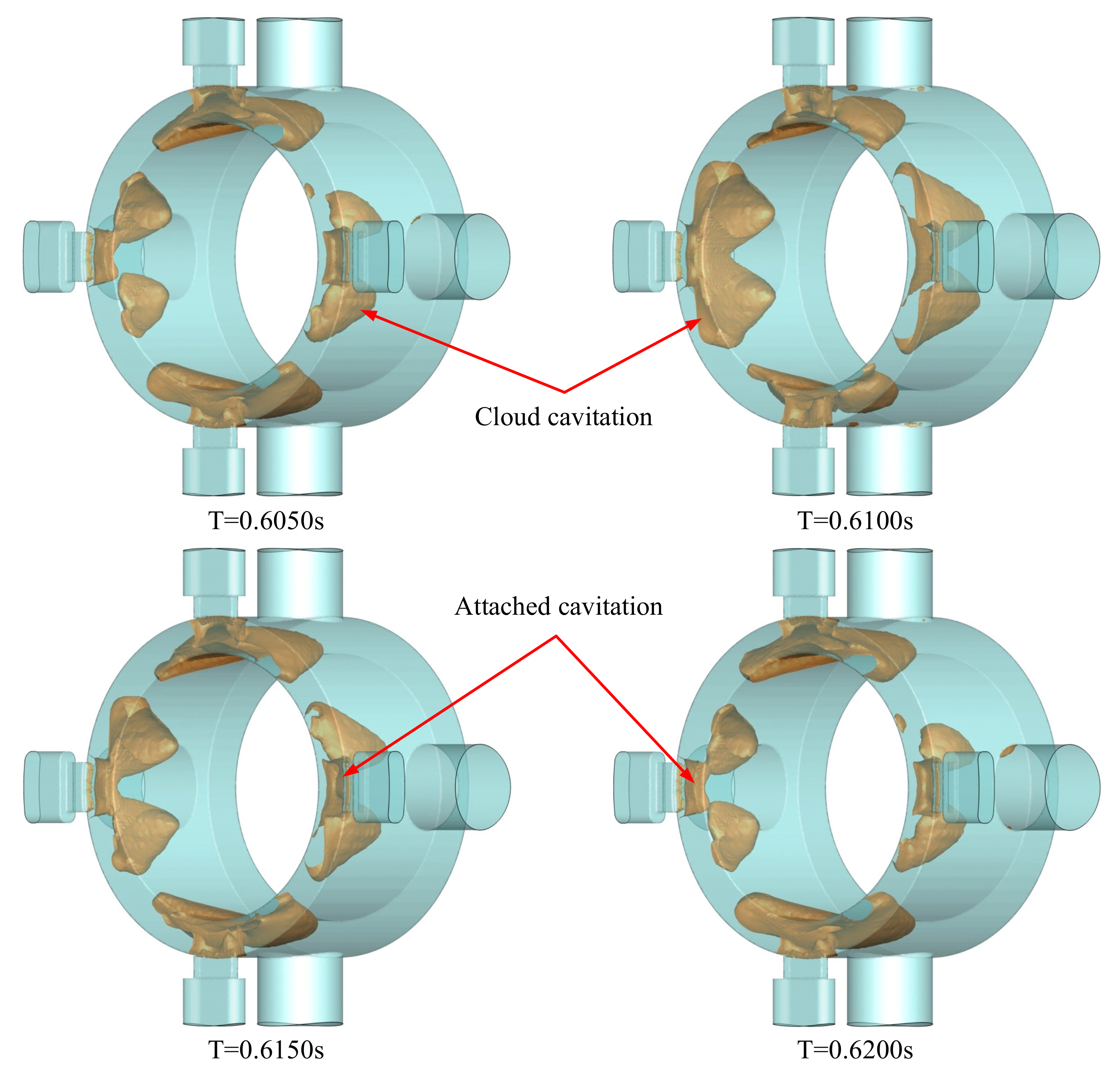
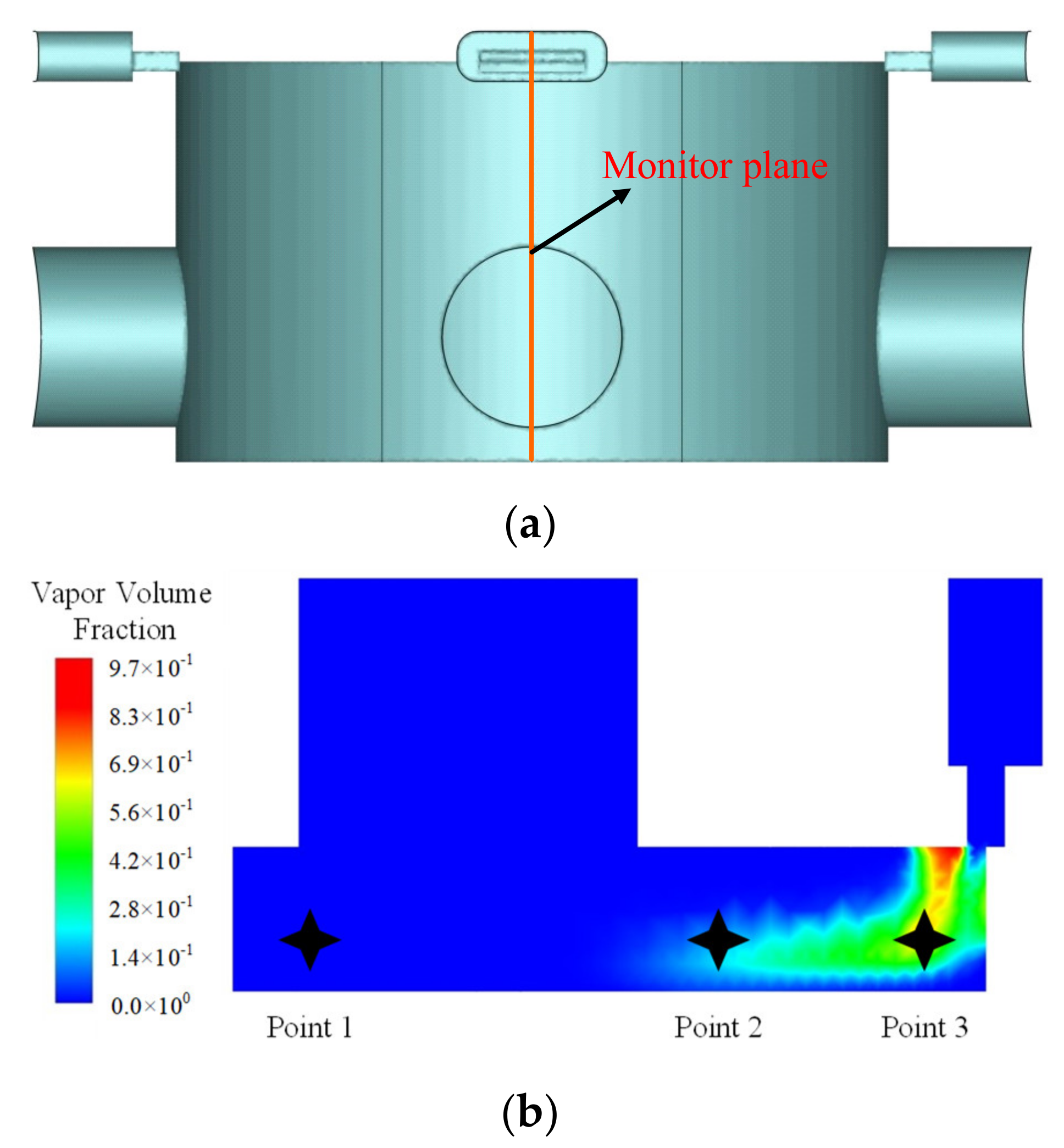
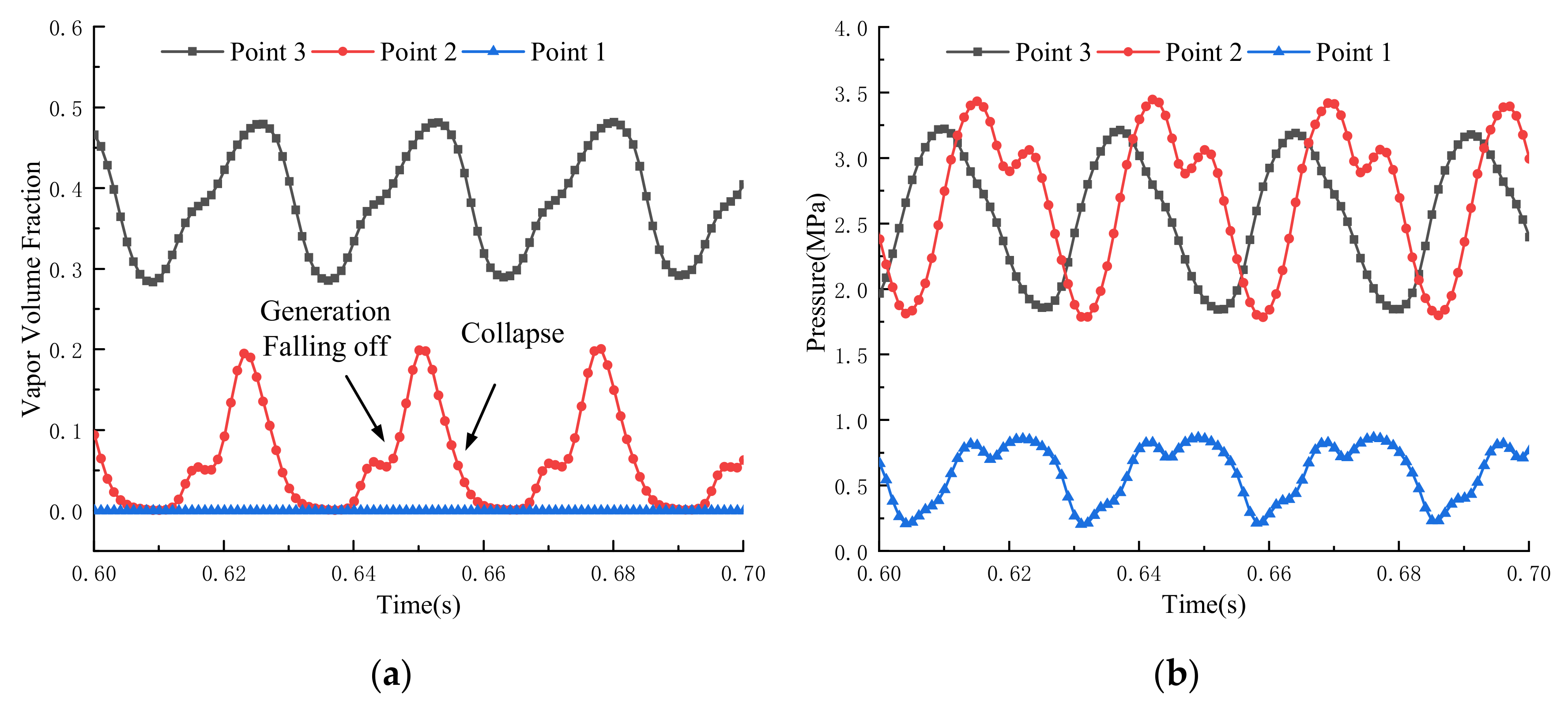
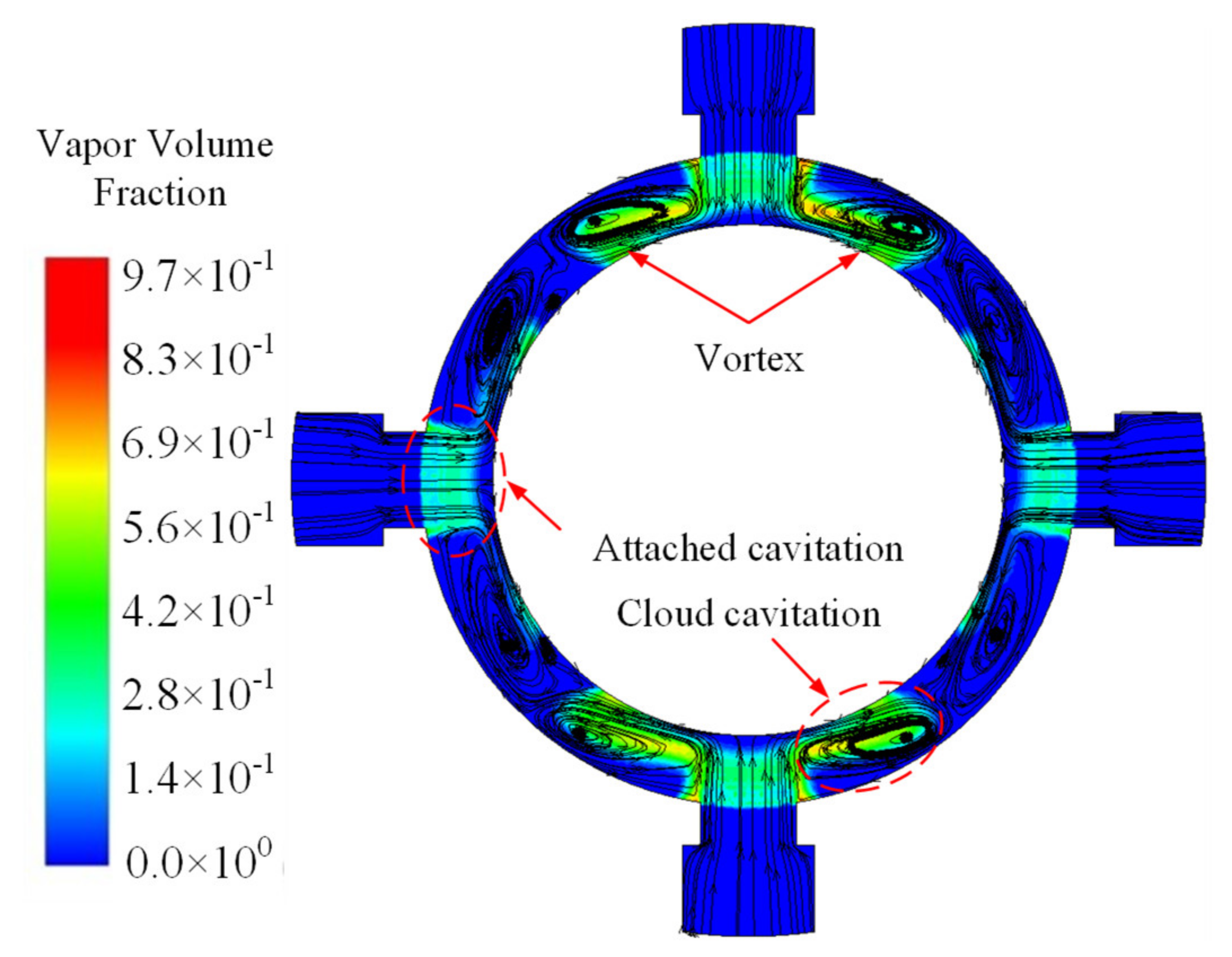


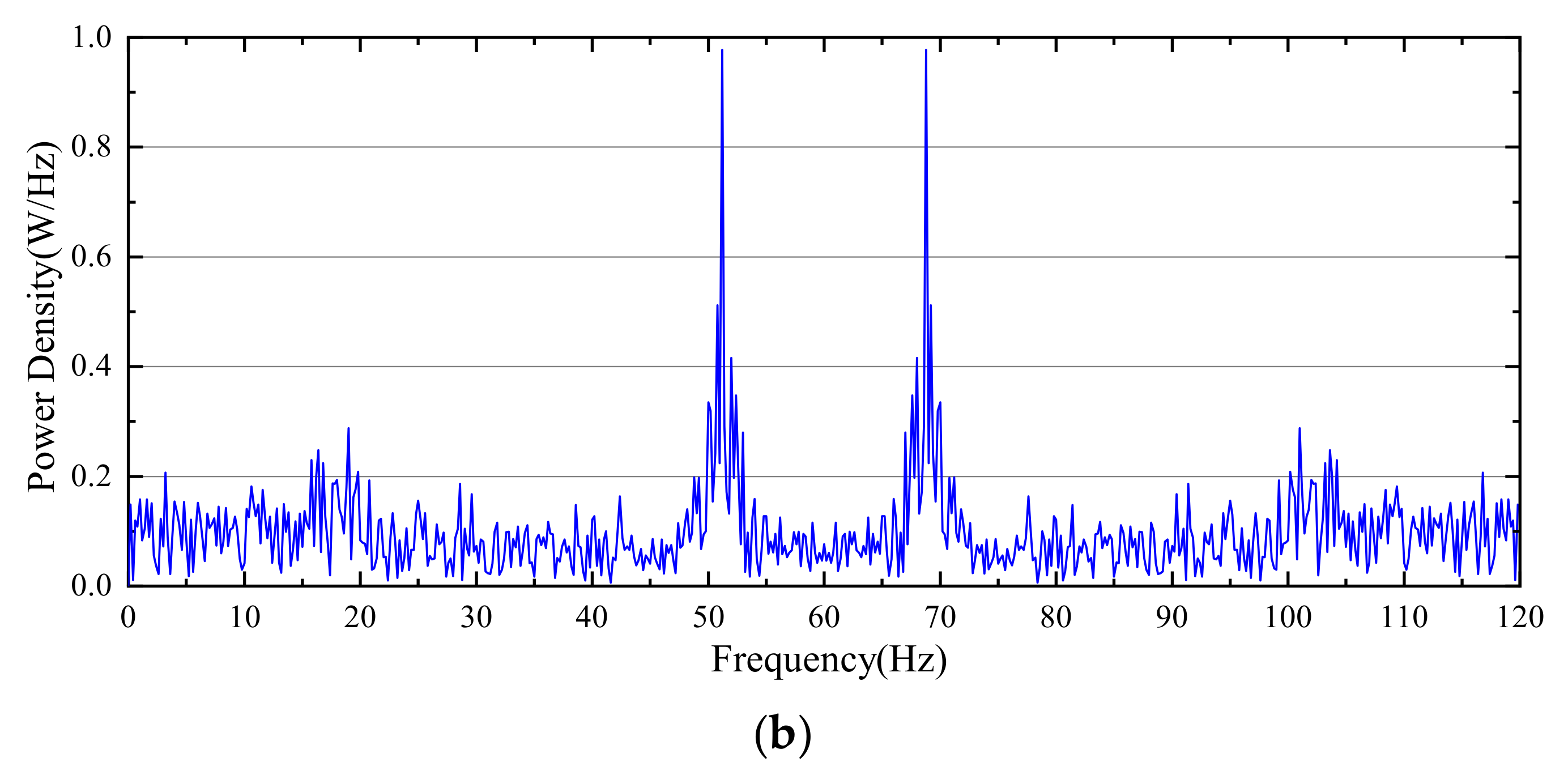
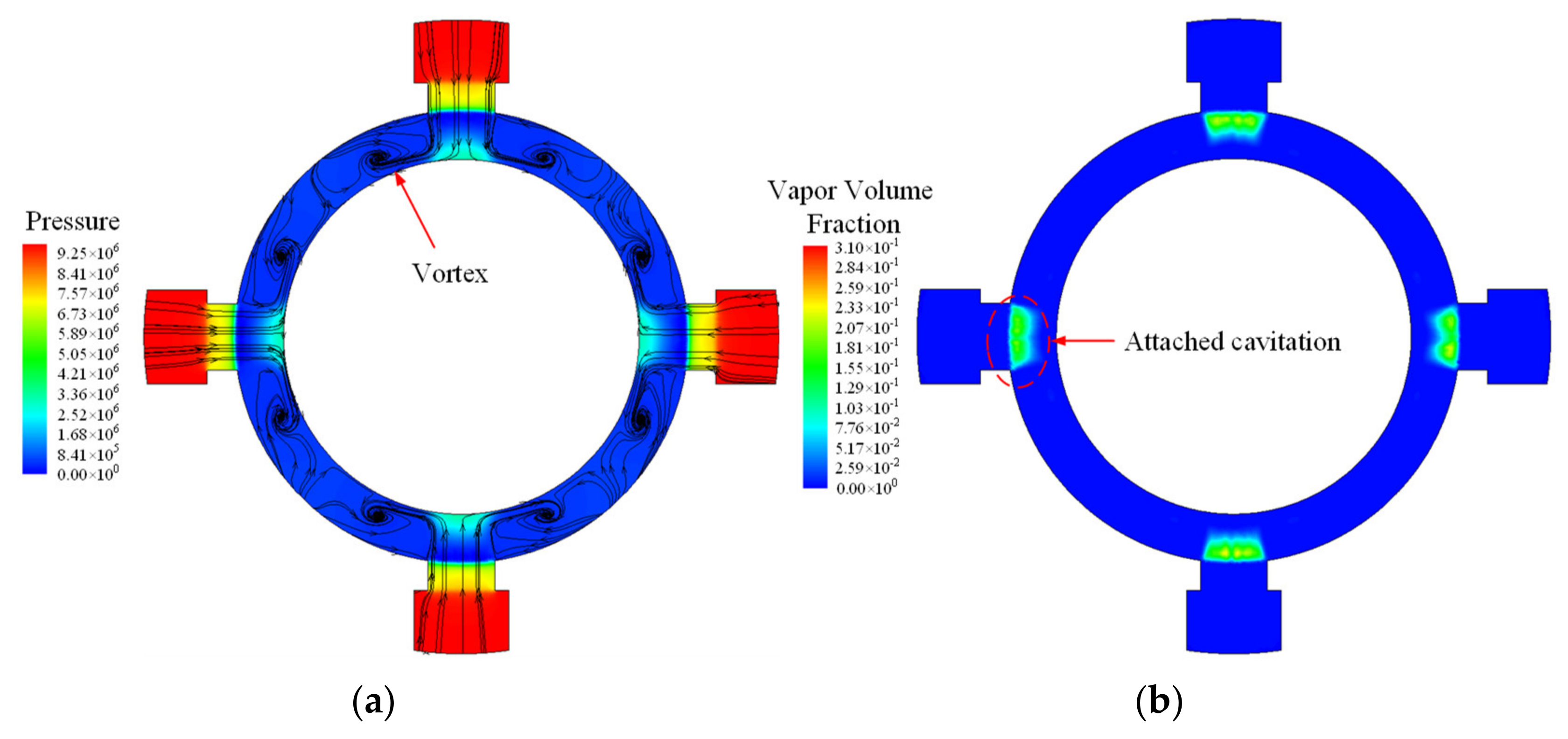


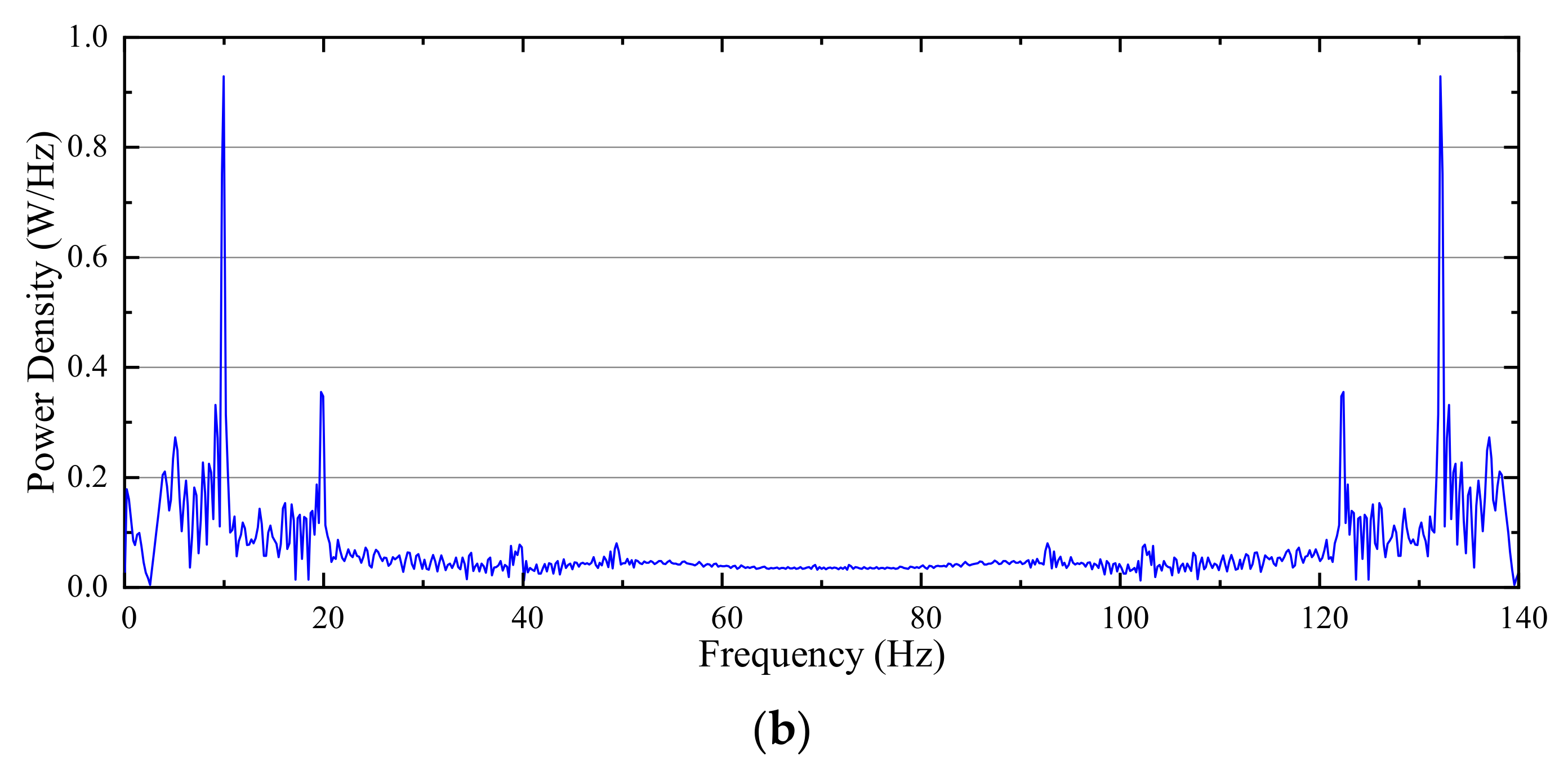
| Solution Approaches | |
| Solver | SIMPLE algorithm |
| Turbulent model | Large-eddy simulation |
| Subgrid-Scale model | WALE |
| Multi-phase model | Mixture |
| Cavitation model | Schner-Sauer |
| Discretization of the pressure equation | PRESTO! |
| Discretization of momentum equation | Second-order upwind |
| Discretization of volume fraction | First-order upwind |
| Under-relaxation of pressure | 0.75 |
| Under-relaxation of momentum | 0.75 |
| Under-relaxation of volume fraction | 0.75 |
| Boundaries and Fluid Parameters | |
| Time step size | 1.00 × 10−5 |
| Inlet pressure | 10.0 MPa |
| Outlet pressure | Atmospheric pressure |
| Liquid oil density | 889 kg/m3 |
| Liquid oil viscosity | 0.045 kg/(m s) |
| Vaporized oil density | 0.55 kg/m3 |
| Vaporized oil viscosity | 1.34 × 10−5 kg/(m s) |
| Vaporized pressure | 10 Pa |
| Bubble number density | 1.00 × 1013 |
Publisher’s Note: MDPI stays neutral with regard to jurisdictional claims in published maps and institutional affiliations. |
© 2021 by the authors. Licensee MDPI, Basel, Switzerland. This article is an open access article distributed under the terms and conditions of the Creative Commons Attribution (CC BY) license (https://creativecommons.org/licenses/by/4.0/).
Share and Cite
Ren, P.; Wang, B.; Zhang, W.; Xie, Z. Influence of Bubbles Causing Cavitation on Spool Oscillation of a Direct Drive Servovalve. Micromachines 2021, 12, 717. https://doi.org/10.3390/mi12060717
Ren P, Wang B, Zhang W, Xie Z. Influence of Bubbles Causing Cavitation on Spool Oscillation of a Direct Drive Servovalve. Micromachines. 2021; 12(6):717. https://doi.org/10.3390/mi12060717
Chicago/Turabian StyleRen, Pengda, Bin Wang, Wei Zhang, and Zhigang Xie. 2021. "Influence of Bubbles Causing Cavitation on Spool Oscillation of a Direct Drive Servovalve" Micromachines 12, no. 6: 717. https://doi.org/10.3390/mi12060717






